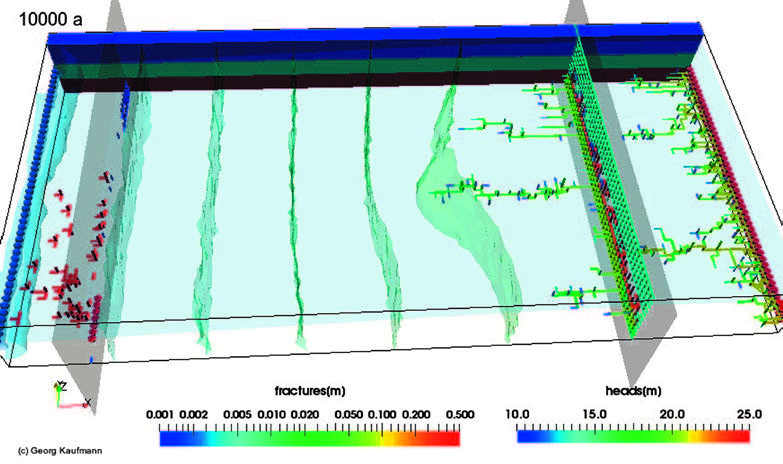Modelling speleogenesis in soluble rocks: A case study from the Permian Zechstein sequences exposed along the southern Harz Mountains and the Kyffhäuser Hills, German
DOI:
https://doi.org/10.3986/ac.v48i2.7282Abstract
Soluble rocks such as limestone, dolomite, gypsum, anhydrite, and salt can be dissolved by water flowing through voids in the rocks. The removal of the dissolved material from fissures and bedding partings by physical and/or chemical dissolution enlarges the permeability of the soluble rocks within geologically short periods of time, ranging from 100,000 years down to decades. This geologically short evolution time of voids in soluble rocks poses a substantial risk of mechanical instability of the enlarged voids, and possible surface deformation, when enlarged voids start to collapse. We describe karst and cave features in the rock sequence exposed along the southern part of the Harz Mountains and the Kyffhäuser Hills in Germany, where limestone/dolomite and anhydrite/gypsum are exposed along a kilometer-wide strip following the foothills of the Harz Mountains. The rocks have been deposited during the Permian Zechstein period, buried, and exposed later through tectonic uplift. The exposed part of this soluble sequence is dominated by karst features. But there are also substantial cave voids deeper in the rock, with no obvious entrance to the surface, which have been discovered by chance through mining activities. Often, the sub-surface void evolution is closely linked to surface deformation, creating collapse sinkholes and subsidence. In the city of Bad Frankenhausen at the foothills of the Kyffhäuser Hills, the evolution of sub surface voids is responsible for the tilting of the church tower of the Oberkirche. We explore the evolution of such a karst system composed of limestone and anhydrite by numerical means, describing flow and transport in a rock mass composed of soluble and insoluble rock sequences, with limestone and anhydrite responsible for the evolution of secondary porosity.
Key words: soluble rocks, karst, mine-cave evolution, collapse sinkholes, numerical modelling.
Modeliranje speleogeneze v topnih kamninah: primer zechsteinskih kamnin v južnem delu gorovja Harz in v hribovju Kyffhäuser
Voda, ki teče skozi pore in razpoke v topnih kamninah, kot so apnenec, dolomit, sadra, anhidrit in sol, raztaplja stene prevodnih poti. Učinkovito odnašanje raztopljene snovi lahko močno poveča hidravlično prevodnost vodonosnika v geološko kratkem času, ki je v izjemnih primerih dolg vsega nekaj desetletij. Hiter razvoj prevotljenosti lahko povzroči mehansko nestabilnost nastalih votlin in posledično ugrezanje površja. Tak primer najdemo v kilometer širokem pasu apnenca, dolomita, sadre in anhidrita, ki se razteza vzdolž južnega dela pogorja Harz in hribovja Kyffhäuser. Sedimenti, ki so se odložili v permskem Zechsteinskem morju, so bili kasneje globoko pokopani in ponovno tektonsko izdani na površje. Izdanki teh kamnin so izrazito kraško preoblikovani, prevotljenost pa je velika tudi v globlje pokopanih kamninah, ki nimajo očitne povezave s površjem in so bile odkrite pri rudarskih delih. Velikokrat se razvoj votlin pod površjem izrazi tudi na površju, kjer nastajajo udornice in grezi. V mestu Bad Frankenhausen ob vznožju hribovja Kyffhauser se je zaradi razvoja votlin pod površjem nagnil cerkveni zvonik. V članku raziskujemo razvoj kraških sistemov v apnencu in anhidritu z numeričnimi modeli. V modelu upoštevamo tok, raztapljanje in prenos snovi v kamninskem masivu, sestavljenem iz topnih in netopnih kamnin, kjer raztapljanje poteka v apnencu in anhidritu.
Ključne besede: topne kamnine, kras, razvoj jam v rudnikih, udorne doline, numerično modeliranje.
Downloads

Downloads
Published
How to Cite
Issue
Section
License
Authors guarantee that the work is their own original creation and does not infringe any statutory or common-law copyright or any proprietary right of any third party. In case of claims by third parties, authors commit their self to defend the interests of the publisher, and shall cover any potential costs.
More in: Submission chapter




